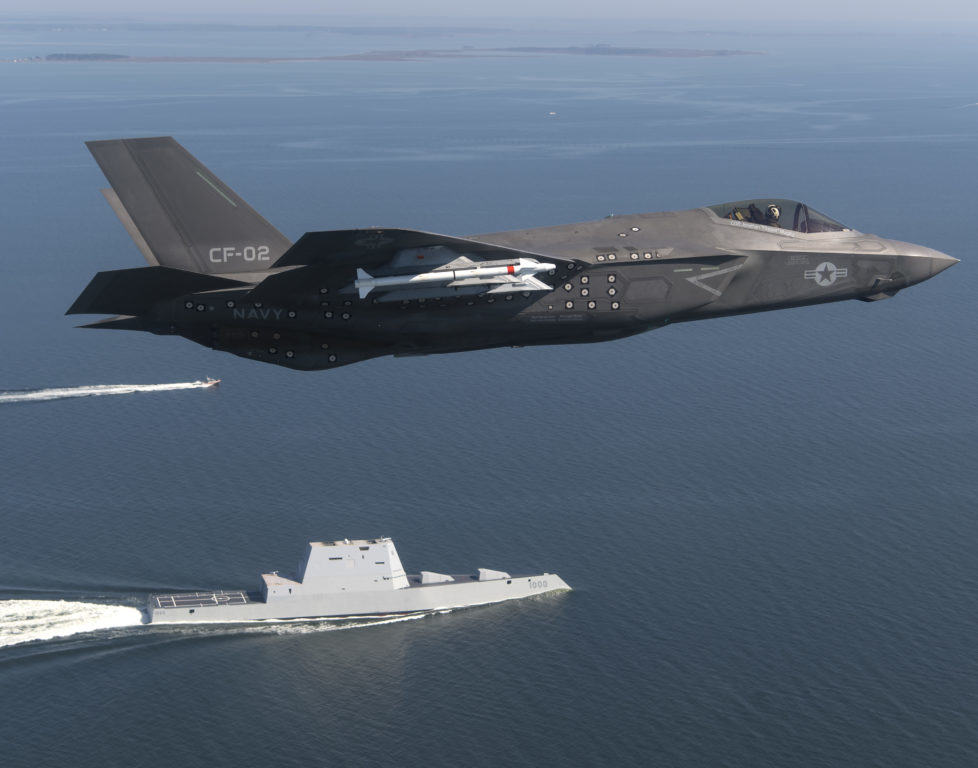

Five of the top national security think tanks exchanged widely varying proposals on the force structure and funding the U.S. armed services would need to confront the global security environment 10 years from now.

An F-35 Lightning II Carrier Variant (CV) piloted by U.S. Marine Corps Maj. Robert “Champ” Guyette II, a test pilot from the F-35 Pax River Integrated Test Force (ITF) assigned to the Salty Dogs of Air Test and Evaluation Squadron (VX) 23, flies over the stealth guided-missile destroyer USS Zumwalt (DDG 1000) as the ship transits the Chesapeake Bay on Oct. 17, 2016. USS Zumwalt, the Navy’s newest and most technologically advanced surface ship, joined the fleet Oct. 15. The F-35C Lightning II — a next generation single-seat, single-engine strike fighter that incorporates stealth technologies, defensive avionics, internal and external weapons, and a revolutionary sensor fusion capability — is designed as the U.S. Navy’s first-day-of-war, survivable strike fighter. The U.S. Navy anticipates declaring the F-35C combat-ready in 2018. (U.S. Navy photo by Andy Wolfe/Released)
The proposals ranged from the minimalist, mind-your-own-business plan from the libertarian-leaning Cato Institute, which would cut defense funding $1.1 trillion below the Obama administration’s long-term budget projects over 10 years, to the aggressive, act-like-a-global-power concept from the conservative American Enterprise Institute, which would add $1.3 trillion — with any force reductions or increases tracking to the funding levels.
The other think tanks — the Center for a New American Security, the Center for Strategic and Budgetary Assessments, and the Center for Strategic and International Studies — fell in between those two extremes on both funding and force levels.
In the conference held in the Newseum’s Knight Studio Oct. 18, AEI’s Tom Donnelly said “we bought almost everything” the president has asked for, but still don’t have the military America needs.
“That tells you how much cutting has been done over the last generation,” he said.
Donnelly based his big increases in spending and force structure on a view that “the world is going to hell in a hand basket,” that from a global view of security “the trend lines are all negative,” and “the old post-Cold War world doesn’t exist any more. We need to build something new.”
Cato’s Benjamin Friedman, however, said his budget and force structure plans were based on “a strategy of restraint,” which “differs from the current prevailing view in Washington.”
“Given our geography, wealth and strategic prowess, we would be secure in the US regardless of how much we buy. This is about how much insurance we need,” Friedman said.
The three others, Paul Scharre of CNAS, Mark Gunzinger of CSBA, and Todd Harrison of CSIS, all agreed that the growing threats required additional spending, but generally favored selective modernization rather than the major force structure growth that Donnelly proposed.
The Navy would fare reasonably well in nearly all the projections, even getting smaller reductions within Cato’s heavy cuts. The submarine force was generally favored by all, with two proposing a new class of guided missile subs to replace the four converted ballistic missile SSGN boats. Cato and CSIS would cut four of the 11 aircraft carriers but CSBA and CNAS called for more carriers.
The Navy would get the biggest boost from CNAS, which called for an increase from the current battle force fleet of 272 to 345. The Navy’s goal is to reach 308 ships by 2020.
CSBA noted that the carriers’ ability to project power is threatened by the proliferation of long-range precision defense weapons and suggested off-setting that by fielding an unmanned carrier-based strike aircraft. The Navy currently plans to follow up its experimental X-47B carrier-capable UAV with the pilotless MQ-25, primarily used as an air refueling aircraft with some ISR capabilities.
The Marine Corps got widely varying support from the five organizations, with Cato proposing to cut it by one-third, CNAS eliminating four infantry battalions and CSIS cutting 6,000 Marines and one air group. Analysts at CSBA proposed an increase to 187,000 Marines from the current plan for 182,000. The Corps probably would gain under AEI’s funding boost.
The Army generally would be increased in size or strengthened by all of the think tanks, except of course Cato, with Donnelly advocating a major boost in armored brigades, which would be used to bolster NATO against Russia.
The Air Force also generally would be strengthened although not substantially increased by the other think tanks, while Cato called for cutting it by one-third. CSIS, CSBA and CNAS all proposed giving the Air Force a low-cost, light-attack aircraft in addition to the F-35A.
Other than Cato, which wants to cancel the entire program, the F-35 was favored along with other stealthy aircraft, including the Air Force’s existing F-22 Raptors and its still-on-paper B-21 long-range strategic strike bomber, now under development. Donnelly urged the Navy to buy the F-35B jump jet version the Marines are getting so it could put them on its aircraft carriers but off-load them in the forward theater to bolster ground forces.
While Cato would chop the nuclear deterrent triad to just the Navy’s ballistic missile submarines, the others all appeared to favor current plans to modernize the Air Force’s nuclear capable bombers and Minuteman III missiles, as well as buying the replacement subs for the Ohio-class SSBNs.
